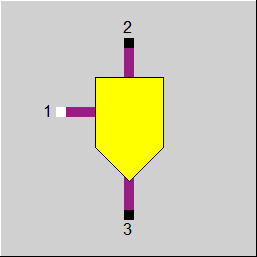

|
Line connections |
|
|
|
1 |
Inlet |
|
|
2 |
Outlet |
|
|
3 |
Branch with mass flow of selected fractions |
|
General User Input Values Physics Used Displays Example
This component works analogously to component 52 (selective splitter, with filter). However, as there are about 100 different possible substances in the case of the universal fluid, here the user will have to specify the name of the respective substance and the respective degree of separation. The possible number of substances to be separated is limited to 10.
Note that only the substances can be separated that are available in the inlet stream. As certain libraries integrate substances in a different way, you have to be aware of the properties of the different libraries. This applies to the following substances:
It is possible to make a conversion between these substances using the components 100/101 (fluid converter/reconverter) and 105 (library selector).
In this component , a mode FM=“phase separation“ has been implemented where a separation between liquid and gaseous fractions is affected. The liquid fractions are output at Outlet 3 and the gaseous fractions at Outlet 2.
However, the phase separation is only possible when using the REFPROP library. Moreover, only one entry in the universal fluid is allowed.
The following should be noted with the separator for universal fluid:
If there is a component 105 (library selector) on an outlet stream, there will be an enthalpy difference due to the different property table that has to be considered in the energy balance. Unfortunately, in the calculation of this table difference the interaction energy was included as well. This was corrected. This results in a change of the outlet temperature, which is correct, however. If it would be possible to perform the separation adiabatic, the elimination of the interaction energy would cause a temperature change. Of course, the resulting temperature must be independent of the selected property libraries. The example file component_109.ebs was extended to illustrate this behaviour.
The heating values of the outlet streams were simply set to the value of the input stream.
If there is a heating value correction, it is considered on stream 2.
|
FM |
Mass flow calculation =2: M1 or M3 given |
|
FSPECH |
Handling of energy balance =0: T3=T1, T2 from energy balance |
|
FADAPT |
Flag for using the adaptation polynomial ADAPT/ adaptation function EADAPT =0: Not used and not evaluated |
|
EADAPT |
Adaptation Function |
|
FSUBST1 |
First substance to separate |
|
JSUBST1 |
SUBST1 separation rate |
|
FSUBST2 |
Second substance to separate |
|
JSUBST2 |
SUBST2 separation rate |
|
FSUBST3 |
Third substance to separate |
|
JSUBST3 |
SUBST3 separation rate |
|
FSUBST4 |
Fourth substance to separate |
|
JSUBST4 |
SUBST4 separation rate |
|
FSUBST5 |
Fith substance to separate |
|
JSUBST5 |
SUBST5 separation rate |
|
FSUBST6 |
Sixth substance to separate |
|
JSUBST6 |
SUBST6 separation rate |
|
FSUBST7 |
Seventh substance to separate |
|
JSUBST7 |
SUBST7 separation rate |
|
FSUBST8 |
Eighth substance to separate |
|
JSUBST8 |
SUBST8 separation rate |
|
FSUBST9 |
Ninth substance to separate |
|
JSUBST9 |
SUBST9 separation rate |
|
FSUBST10 |
Tenth substance to separate |
|
JSUBST10 |
SUBST10 separation rate |
Generally, all inputs that are visible are required. But, often default values are provided.
For more information on colour of the input fields and their descriptions see Edit Component\Specification values
For more information on design vs. off-design and nominal values see General\Accept Nominal values
 |
Display Option 1 |
Click here >> Component 109 Demo << to load an example.